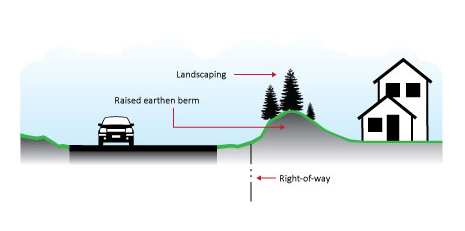Noise Control
Noise Control
The control of unwanted sound coming from the roadway.
Standards
AASHTO (A Policy of Geometric Design of Highways and Streets) - Efforts should be made to minimize the radiation of noise into noise-sensitive areas along the highway. Reducing noise can be accomplished by building an earthen or concrete barrier between the noise source and the receiver. Shrubs, trees, or ground covers are not very efficient in shielding sound because of their permeability to air flow. However, almost all buffer plantings offer some noise reduction, and exceptionally wide and dense plantings may result in substantial noise reductions. Noise reduction should be considered in the early design stages and the terrain should be taken into advantage in forming a natural barrier so that the appearance is aesthetically pleasing.
PennDOT: Use AASHTO Standards for earthen berms / landscape screens. For sound wall/noise barriers, see PennDOT Publication 24: Project Level Highway Traffic Noise Handbook
Comments
Screening and buffering devices such as raised earthen berms with landscaping, staggered landscaping within a designated buffer area and fence or wall structures, are effective for many uses. They are predominantly used to:
- reduce noise;
- provide privacy for dwelling units;
- separate incompatible land uses;
- shield unattractive structures from view;
- reduce light infiltration and glare; and,
- create visually appealing views, vistas and space.
When considering noise abatement measures it is important to recognize that it is more cost-effective to include them in the original design plan than to add them afterwards. Also, the use of existing, mature vegetation can properly enhance screened and buffered areas.
Earthen Berm with Landscaping

The installation of sound walls along a highway are determined by PennDOT's Noise Abatement Process, as outlined in their Project Level Highway Traffic Noise Handbook. The following are excerpts from the PennDOT brochure "Sound Decisions About Highway Noise Abatement.
What Projects Are Eligible?
Only certain highway improvement projects are eligible for noise mitigation in Pennsylvania. These projects have the potential to alter the acoustical environment and are analyzed for noise impacts and abatement is considered. The scope of these types of projects include highways on new locations, substantial alteration of either the vertical and/or horizontal alignment on existing highways, and various other improvement projects, including certain auxiliary lanes, weigh stations, rest areas, etc.
For eligible projects, there is a specific process that PennDOT uses to identify communities that will be considered for noise abatement and to determine whether noise abatement measures can be implemented within state or federal guidelines. This process includes the following steps:
- Determine which land-uses in the project could be affected by the project - The Federal Highway Administration (FHWA) has established noise abatement criteria for various land uses which PennDOT uses to determine impacts and where abatement consideration is warranted. Locations such as residences, libraries, houses of worship, hospitals, schools and parks are often the most common land uses that receive abatement consideration.
- Monitor Noise Levels - After noise-sensitive locations that may be affected by the proposed highway project have been identified, existing traffic noise levels are monitored at locations that are representative of affected neighborhoods. The results of the monitoring sessions are used to ensure that the noise prediction model will provide accurate results.
- Noise Modeling - Computer modeling is performed with the FHWA TNM Model to assess future conditions in light of the proposed improvements. Noise projections are made for the worst-case future build condition using forecasted traffic information 20 years in future when the highway is at its maximum capacity.
- Noise Abatement Consideration - PennDOT must determine that noise abatement measures are warranted, feasible, and reasonable at noise-sensitive areas.
- To determine whether abatement consideration is warranted, the noise modeling projections are compared to noise impact criteria for the land use. Using criteria based on FHWA guidelines, abatement is warranted if the future noise levels approach or exceed the noise abatement criteria or are elevated by 10 decibels [dB(A)]above the existing conditions.
- Feasible noise barriers are those that provide at least 5 dB(A) of noise reduction to noise sensitive locations and pose no safety, engineering, or access restrictions.
- For a barrier to be reasonable it must be cost effective and maintenance, constructability, drainage and utility impacts, as well as the desires of the affected residents, must be considered.
Recommendations
- Consider the unique characteristics of a site when conducting the site analysis and design.
- Provide an adequate right-of-way for the screening and buffering of incompatible land uses, reverse frontage lots and residential areas along highways.
- Incorporate existing, mature vegetation into the design. Transplant existing trees whenever possible rather than destroy them.
- For sound walls, follow the guidance of PennDOT Publication 24: Project Level Highway Traffic Noise Handbook.
- Provide some form of a vegetative treatment to soften the appearance of concrete barriers if they are used.

Noise wall between PA 100 and adjacent neighborhood.


